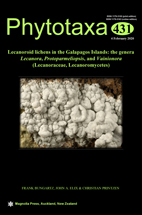Abstract
As part of the Galapagos lichen inventory, species in the genus Lecanora and closely related genera have been revised, using both historic and recent collections. A total of 34 species are reported of which fourteen are new to science: Lecanora atro-ocellata, L. cactacea, L. cerebriformis, L. cerebrosorediata, L. confusoides, L. darwiniana, L. kalbii, L. malagae, L. ombligulata, L. pyrrhosporoides, L. subaureoides, L. terpenoidea, Protoparmeliopsis ertzii, and Vainionora nugrae. The taxonomy of Lecanora s.l. remains poorly resolved. Based on morphological similarities we assign the species treated here to several informal groups: the largest, with thirteen species, is the Lecanora subfusca-group, i.e., the core of Lecanora s.str. In the archipelago, most species in this group grow on bark but a few occur on rock. Seven species, assigned here to the L. marginata-group, occur exclusively on rock. Two species are included in the L. pallida-group, which may also include L. cactacea. However, this species is retained in the L. subfusca-group as it lacks densely pruinose discs. Three species are treated as part of the L. pinguis group. Six species belong to a heterogeneous assemblage commonly referred to as the L. varia-group. Species in this group are not necessarily closely related, but assigning them to phylogenetically defined, “natural” clades, i.e., the L. symmicta- or L. polytropa-groups, is currently not possible. Species of Vainionora share characteristics with these species as well as with species in the L. subfusca-group; the characters used to distinguish Vainionora from Lecanora are reviewed. A total of seven Lecanora species previously reported for the Galapagos could not be confirmed. Detailed descriptions for all thirty-four species of Lecanora, Protoparmeliopsis and Vainionora so far known from Galapagos are presented. An identification key for these species is provided. Bryonora granulata Fryday is reported as new to Galapagos.

